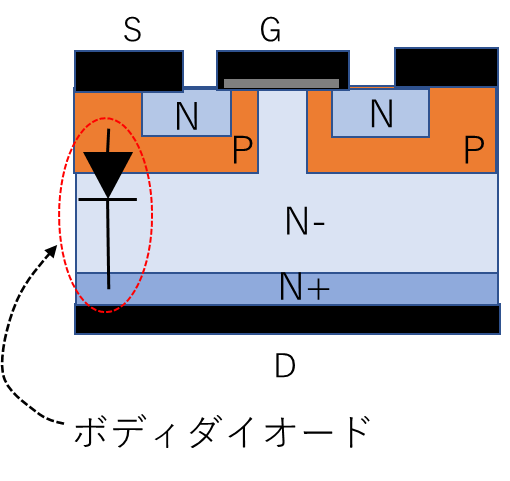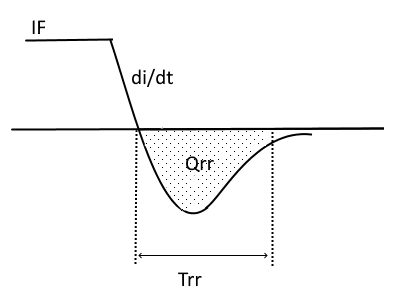What is a body diode
A diode is formed between P on the source side and N on the drift layer in a vertical planar Nch-MOSFET (hereafter referred to as MOSFET). This is called a body diode, and the direction is the forward direction from source to drain. Also known as a parasitic diode, it is basically unrelated to the switching operation of MOSFETs, but nowadays there are many MOSFETs that also specify body diode characteristics.
For example, a freewheeling diode may be required in an inverter circuit. A freewheeling diode is a diode that freewheels and consumes the current remaining in the inductance component. If the load in the circuit has inductance, the current in the inductance will not switch immediately when the MOSFET switches from on to off. By using a free-wheeling diode connected in anti-parallel to the MOSFET during switching to allow current to flow, the energy stored in the inductance can also be output and the surge applied to the MOSFET can be reduced.
In this case, a freewheeling diode is required between the source and drain of the MOSFET, but a body diode may be used instead. Forward direction (VF) and reverse recovery time (Trr) are important factors in diode loss, but if the body diode has good characteristics, it will not need to be externally mounted, which will help reduce circuit size.


Body diode of SiC-MOSFET
Both SiC-MOSFETs and Si-MOSFETs have PN junction body diodes. Since SiC has a wide bandgap, conduction loss occurs when the forward voltage (VF) of the body diode is about 4 V. However, if the conduction period of the body diode is short, there is no significant effect on circuit operation. In the body diode of SiC-MOSFET, the lifetime of minority carriers is shorter than that of Si, so the reverse recovery time is shorter and the reverse recovery loss is kept smaller.
In some cases, discrete SiC-SBDs are used externally in search of smaller forward voltage and reverse recovery time, but the loss reduction effect varies depending on the circuit and operating conditions.
What does the reverse recovery time (Trr) depend on?
The reverse recovery time of a PN junction diode basically depends on the lifetime of minority carriers, which is the same for SiC, but the minority carrier lifetime of SiC is shorter than that of Si, so the reverse recovery time is also shorter. Become. The reverse recovery time (Trr) also changes depending on conditions such as current and temperature.
The reverse recovery time (Trr) tends to increase when the slope of the reverse current change with respect to time (di/dt) is large, when the element temperature rises, or when the forward current increases.
As an example of Microchip's SiC-MOSFET, there are products with the following Trr.
Vdss/Rdson ==> Trr
1200V / 80mΩ ==> 34nS
1200V / 17mΩ ==> 40nS
700V / 60mΩ ==> 25nS
700V / 15mΩ ==> 38nS
Click here for Microchip SiC product information
Inquiry
If you have any questions regarding this article, please contact us below.
To Microchip manufacturer information Top
Click below to return to the Microchip manufacturer information top page.
